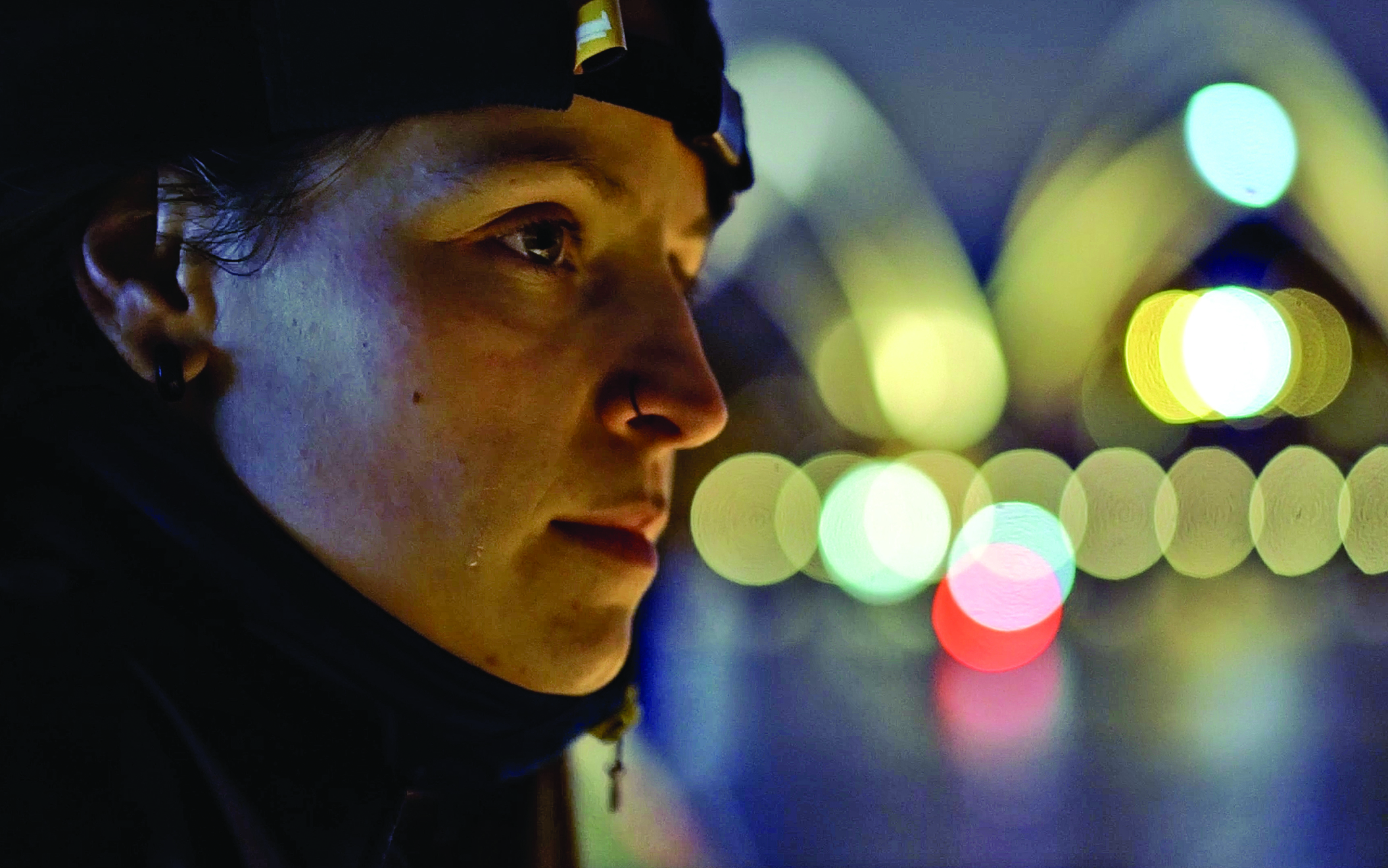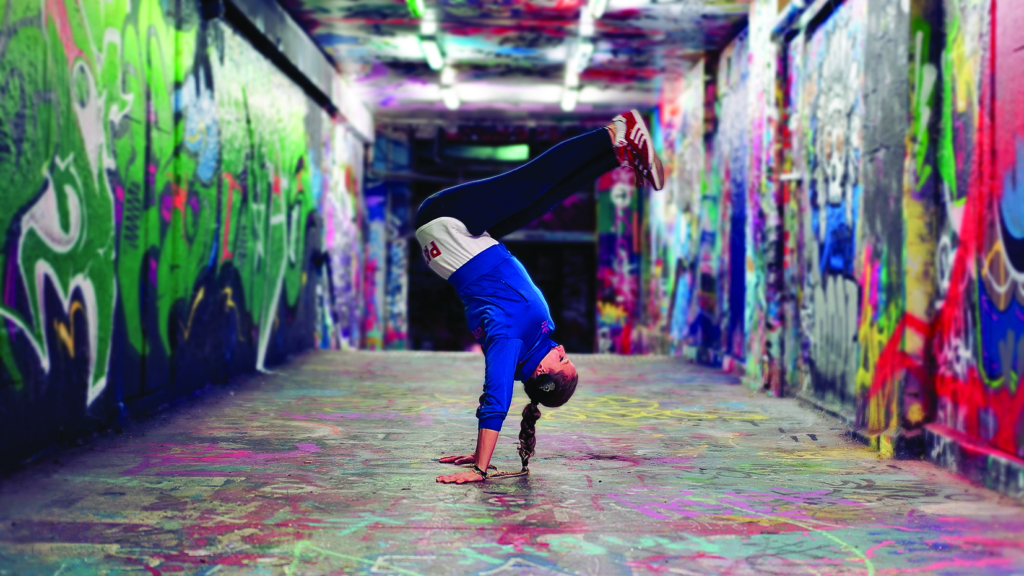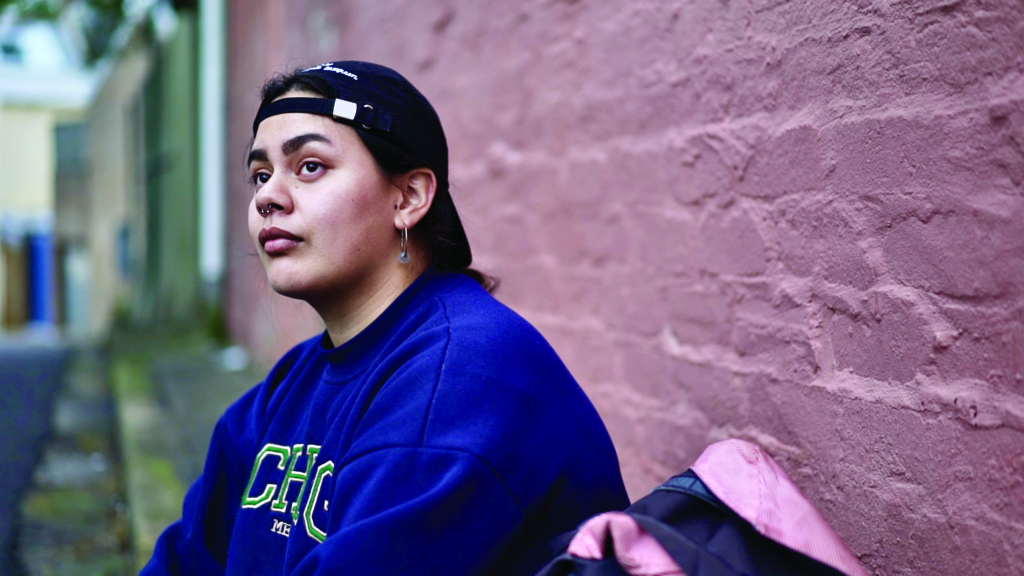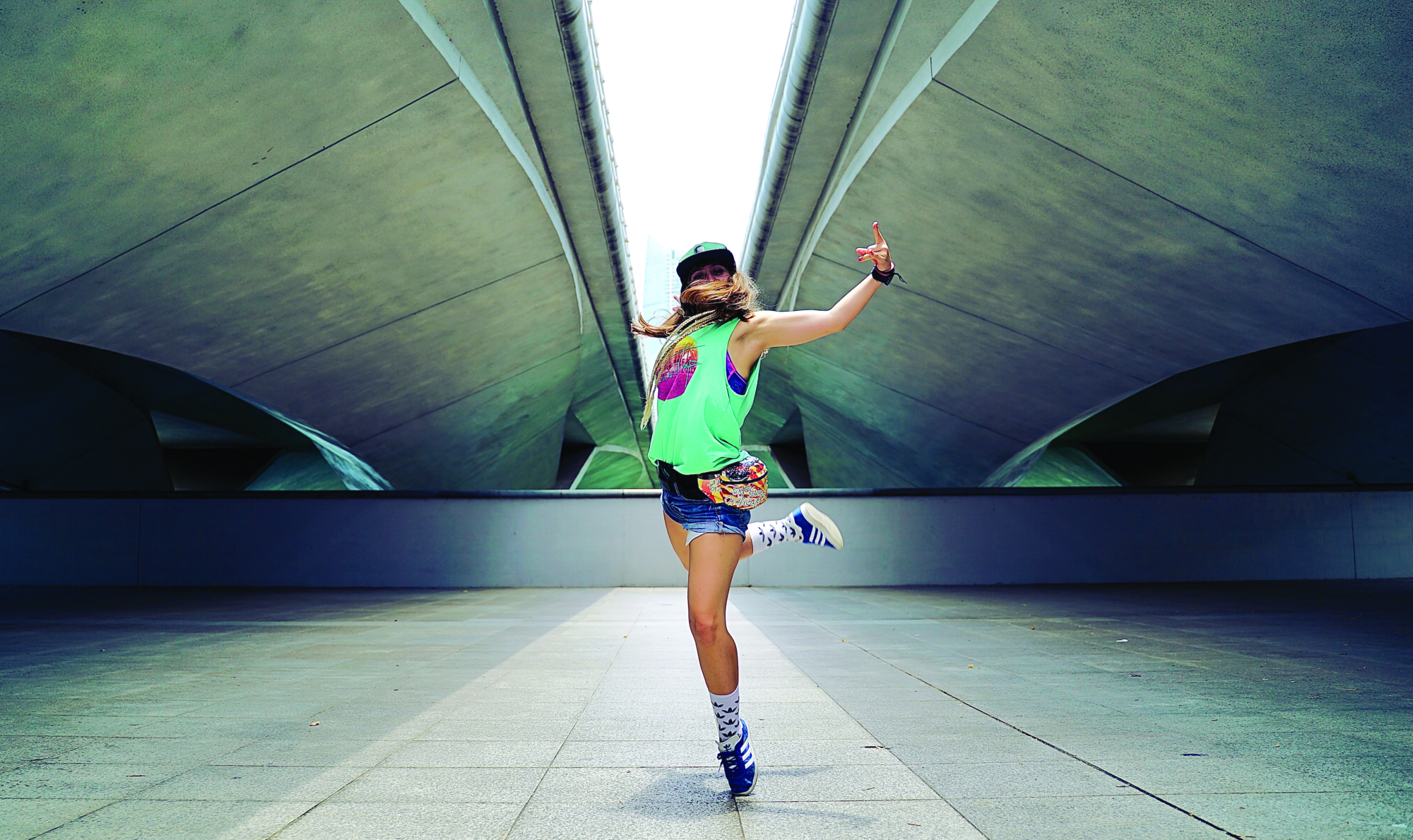In Luke Cornish’s award-winning[1]The film won both the Documentary Australia Award for Australian Documentary and the Audience Award for Best Documentary at the 2022 Sydney Film Festival. documentary Keep Stepping (2022), competitive street dance is represented as a sport and artform fuelled by personal ambition and community, for which dancers lay their hearts, bodies and careers on the line. Throughout the film, we see the dancers move instinctively with rhythm and style; as spectators cheer from the sidelines, the atmosphere heats up. For a moment – in among the breakdancing, the popping and locking – time slows down.
Set on Sydney’s urban fringes, Keep Stepping makes it clear early on that street dance isn’t for the faint-hearted. Driven by passion, the practice is most adamantly described in the film’s opening montage by three young men sitting on a kerb as ‘not a hobby; this is something that we love’. In a clip within this sequence, Cornish (who also serves as co-cinematographer and editor) captures an emcee’s introduction from low angle: ‘Are you ready?’ he shouts, energising the crowd. In anticipation of the knockout battle about to begin, lines of people roar in anticipation. Cutting between slow-motion sequences of dancers flying up and turning around in the air, moving though sweat and with the thrums of the music, the footage shifts to dancers explaining what’s on the line for them: winning competitions, and, with that, a chance at global recognition and success.
Through Cornish’s dynamic direction, the documentary doesn’t play out its dance battles for pure entertainment value; instead, it gives audiences insights into the mental and physical toughness of its young subjects, who all hope to earn their stripes and make it – both artistically and commercially – as street dancers. This, perhaps, is the reason why the documentary also zooms in on where the main competition is conceived: within the boardroom offices of Destructive Steps Dance Association (DSDA), a non-profit headquartered in Sydney’s Chinatown district. Inside, Jo Hyeon Yoon and his team are organising the association’s signature event, Destructive Steps, a festival in which thousands of street dancers from Australia and around the world gather to compete, and are offered the potentially life-changing opportunity to showcase their talent on the international circuit. The event’s tenth year, in 2018, also marks the final one as director for Yoon, who built the festival from the ground up.

Keep Stepping’s structure primarily centres on the twelve-week countdown to the festival, where the stakes for the documentary’s main subjects come into tight focus. This is where we meet the film’s two central protagonists, Gabi Quinsacara and Patricia Crasmaruc (who battles as ‘Patrix’), whose personalities and backgrounds differ as much as their styles of street dance (an umbrella term that encapsulates hip-hop dance as well as other kinetic artforms born from the streets). The former practises a street dance move called ‘popping’, a style characterised by sudden tensing and releasing of muscles to music beats;[2]See Charise Roberts, ‘What Is Popping? (Popping Dance)’, STEEZY Blog,7 May 2022, <https://www.steezy.co/posts/what-is-popping-dance>, accessed 11 July 2022. while the latter – who battles as a ‘b-girl’, or female breakdancer – spends hours perfecting her ‘windmill’, a move in which the dancer’s torso moves in a circular path as their legs make a V shape in the air. The two young women compete in different categories, but Cornish intricately develops a thread intertwining their stories.
In sequences featuring Crasmaruc, the camera yields to her strong, cheeky personality, expressed in part through the various personal mantras that are depicted via close-ups of sticky notes on her bedroom wall (examples include ‘The major key to your better future is you’ and ‘You become what you think about’). These notes’ emphasis on ‘you’ sets up early on that her journey is self-earned, and driven by her brazen, hyper-focused attitude.
Keep Stepping opens with a night-time shot of Crasmaruc attempting the ‘windmill’ on a cold concrete floor, struggling to keep her legs up as she spins upside-down outside against yellow-tinged backstreet lights. ‘Why did I not stop dancing? It’s because it’s all the time a challenge,’ she muses in voiceover. ‘The first challenge is the real challenge: do you want to do it, or [do] you just want to try it?’ Cornish exhibits the sheer will that drives her ambition, cutting between rough, shaky home-video footage of her practising alone in empty studio spaces and polished talking-head interviews in which she reflects on herself and her dance journey. ‘I was pretty confident about [being one of the only girls in the scene], and I never showed if I [was] intimidated,’ she asserts, laughing. ‘Nobody will know […] That’s my game.’ In another sequence, we see her looking at herself in the mirror as she puts on lipstick; it’s as if she’s painting on her own independence as a kind of survival tactic.

Crasmaruc’s self-assured demeanour is placed in juxtaposition with the serene, more soft-spoken Quinsacara, who speaks about her struggles navigating her shared Chilean and Samoan cultural identity. Cornish tracks how Quinsacara’s quiet magnetism is unleashed on stage in her sets with rousing vitality, capturing a certain ease and effortlessness that contrasts with her wavering self-belief in everyday life. In an interview to camera, she speaks about the necessity of turning down the voice in the back of her head ‘that says [she] can’t do it’ and instead homing in on the confidence that competitive freestyling requires. However, Cornish’s editing also insightfully frames the contrast between Crasmaruc’s self-empowerment and Quinsacara’s reliance on her friendship circle for support. When the latter practises in studios, she’s often surrounded by friends, who appear alongside her in the long mirrors. She is constantly offered gentle advice by her boyfriend, Will Mak, who leaves encouraging sticky notes on her desk with messages like ‘Keep pushing bubba!’ In a sweet moment, Quinsacara admits, ‘I don’t know where I’d be without [Will’s] love,’ before looking away in embarrassment. The film’s candidness in these moments offers us a glimpse into her shy, endearing personality off stage (DSDA director Alice Tauv describes her as the ‘most loveable, huggable creature on this Earth’).
Up until this point, Cornish’s directorial style has been largely observational … But it’s in this final chapter that his direction comes alive with incredible vibrancy, imbuing these scenes with the adrenaline that pumps through the battles.
Through these intimate character studies, Keep Stepping finds a seamless path past the romantic notion of the artist’s dream and into an examination of the economic realities of pursuing a career as a creative. While Quinsacara questions what it will be like growing older in the scene, Crasmaruc is optimistic about her love for the sport, still picturing herself at forty or fifty ‘wanting to compete’. But, as a Romanian citizen, Crasmaruc is fighting another battle: finding a way to gain permanent residency so she can stay in Australia. In a rare moment of vulnerability in which she talks about her residency struggles, she observes her status as an outsider: ‘It’s interesting how you’re in a part of the world where you just want to be there, but you can’t,’ she says. Through the gradual unveiling of Crasmaruc’s story, Cornish clues us in to how her charismatic – albeit intense – temperament may be a front for the insecurity she’s handling off screen. Yet her fierce perseverance remains ever-present. When the filmmaker asks her in an earlier scene whether battling is enough for her, she hesitates for a second, but her answer is simple: ‘Yes … I don’t need much.’

Keep Stepping plays out as a love letter not only to its street dancers but also to those building up the local scene’s reputation and legacy in the future. When the Destructive Steps festival kicks off in the third act, the documentary finally lets its most thrilling street dance sequences unfold. Up until this point, Cornish’s directorial style has been largely observational, occasionally interjecting with a question or prompt from behind the camera. But it’s in this final chapter that his direction comes alive with incredible vibrancy, imbuing these scenes with the adrenaline that pumps through the battles. Mostly shooting alone, Cornish filmed the documentary over the course of seven years,[3]See Andrew F Peirce, ‘Keep Stepping Director Luke Cornish Talks About His Path from Editing Dora the Explorer Promos to Making a Documentary About Street Dancing in This Interview’, The Curb,11 June 2022, <https://www.thecurb.com.au/keep-stepping-director-luke-cornish-talks-about-his-path-from-editing-dora-the-explorer-promos-to-making-a-documentary-about-street-dancing-in-this-interview/>, accessed 11 July 2022. and the time he spent inside this community of dancers gives these sequences an exciting, lived-in feeling, attuned to his subjects’ improvisatory sets. Ultimately, he says, music played a key role in cinematically translating the energy he witnessed to film:
The music track is the story structure. There’s a beginning, a break in the middle, [and] that’s the end of your Act 1. There’s the bridge; that’s the end of Act 2. It’s story structure 100 per cent, and I can see it in a waveform. I can even see when Gabi is about to crack a pop, because I can hear the snare [drum]. The music tells me what to do.
Using slow motion to match each wondrous hand movement, leg swing or airborne split to the beats of the music, Cornish elevates the athleticism and artistic performance of these battles to a higher, more exhilarating plane.
By depicting the difficulties his subjects endure, Cornish highlights that the real prize is the sense of community that these performers have found. As Quinsacara’s performance plays out during the preliminary round of Destructive Steps, Cornish cuts back to her putting on her eyeliner in the mirror as she observes that, like her, many street dancers have come from a background in which they lacked family support. Yoon, who is himself estranged from his Korean migrant parents, acknowledges this too, commenting that the dance community allows both an escape and an opportunity to ‘uplift people from hardships’. When he tears up during his farewell speech at Destructive Steps, Cornish doesn’t cut away; instead, we see the full extent of emotions welling up in Yoon’s eyes before he wipes them with the back of his hand. As we see him fall into his colleagues’ embraces, it’s clear that the self-made street dance family Yoon has created has helped forge his own identity. ‘In this culture, I’m just who I am,’ he says, bowing down to the crowd before him in gratitude.
In joining the dots between grit and sacrifice and depicting the therapeutic effect that comes from pushing through adversities, Keep Stepping details how battling – particularly at its highest levels – hinges on the power of personal expression. Born in the Puerto Rican and African-American communities of New York City in the 1970s, hip-hop and street dance have since evolved into an international phenomenon in the twenty-first century, with styles being adapted by local scenes around the world and younger generations – many of whom hail from marginalised backgrounds – using the artform as a means of channelling their emotions.[4]See DJ Renegade, ‘The History of Hip-hop Dance’, BBC Arts, 24 April 2015, <https://www.bbc.co.uk/programmes/articles/5CWQyWXZ4p7hr6NxG2L5qG9/the-history-of-hip-hop-dance>, accessed 11 July 2022. Australia’s own hip-hop history has been relatively brief, arising here initially through breakdancing and graffiti and only later through music.[5]See Paul Donoughue, ‘Hip Hop in Australia, from Molly Meldrum’s “Rap Dancing” to Tkay Maidza’, Double J,25 March 2019, <https://www.abc.net.au/doublej/music-reads/features/australian-hip-hop-history-in-six-objects/10929758>, accessed 11 July 2022. Cornish’s documentary offers a visual nod to the uniquely Australian flavour this artform has developed, hinting at it through drone shots of whizzing Sydney trains – complete with their distinctive yellow doors – the Opera House and dance studios located above travel agencies in Haymarket.
The dancers, too, have found unique ways of drawing from their deeply personal experiences to inform their movements and pieces. In the final scene of the documentary, after the raucous energy of Destructive Steps has subsided, Quinsacara finally finds catharsis in a performance that combines Samoan cultural dance with her own popping style. Here, dance marks the point at which she can reconcile her own connection to culture. Dressed in what Quinsacara herself describes as a ‘half-traditional’ gold-and-black outfit, she elegantly mimes and dances to a speech about the devastating effects that climate change has had on Pacific island nations, her eyes welling up in the process. Quinsacara’s performance is moving, intimately interpretive and all the more potent as it culminates in a prerecorded plea: ‘I’m angry and I’m scared […] Let us remember: this is our story; and our story is not one of destruction, but is one of creation.’ The height of emotions that this last scene carries is representative of the heart and staying power of Cornish’s documentary as a whole, and of the losses, hopes and joys experienced in the lives he’s captured over the years. As a pay-off, it’s a riveting result – full of fight, tenacity and triumph.
Endnotes
| 1 | The film won both the Documentary Australia Award for Australian Documentary and the Audience Award for Best Documentary at the 2022 Sydney Film Festival. |
|---|---|
| 2 | See Charise Roberts, ‘What Is Popping? (Popping Dance)’, STEEZY Blog,7 May 2022, <https://www.steezy.co/posts/what-is-popping-dance>, accessed 11 July 2022. |
| 3 | See Andrew F Peirce, ‘Keep Stepping Director Luke Cornish Talks About His Path from Editing Dora the Explorer Promos to Making a Documentary About Street Dancing in This Interview’, The Curb,11 June 2022, <https://www.thecurb.com.au/keep-stepping-director-luke-cornish-talks-about-his-path-from-editing-dora-the-explorer-promos-to-making-a-documentary-about-street-dancing-in-this-interview/>, accessed 11 July 2022. |
| 4 | See DJ Renegade, ‘The History of Hip-hop Dance’, BBC Arts, 24 April 2015, <https://www.bbc.co.uk/programmes/articles/5CWQyWXZ4p7hr6NxG2L5qG9/the-history-of-hip-hop-dance>, accessed 11 July 2022. |
| 5 | See Paul Donoughue, ‘Hip Hop in Australia, from Molly Meldrum’s “Rap Dancing” to Tkay Maidza’, Double J,25 March 2019, <https://www.abc.net.au/doublej/music-reads/features/australian-hip-hop-history-in-six-objects/10929758>, accessed 11 July 2022. |





